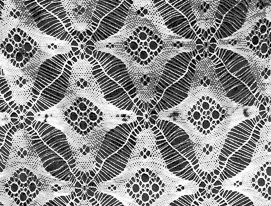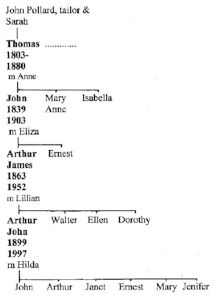 Beeston and Lace Making - In the 18th century, Leicestershire, Derbyshire and Nottinghamshire were
at the centre of a framework knitting industry, producing a wide range of garments in wool, silk and, later, cotton. This was a
cottage industry, with hand-powered machines. It provided employment for the whole family, the men operating the heavy knitting machines,
while the women and children sewed up garments, wound yarn and undertook other ancillary tasks. Some men prospered and became hosiers,
renting out frames, providing the yarn and marketing the product; middlemen acted as links between hosier and knitters, and frame-smiths
produced and developed the machines. Beeston was in the heart of this area, and some forty framework knitters are known in the parish in the
period 1700-17401, the number increasing through the century.
Beeston and Lace Making - In the 18th century, Leicestershire, Derbyshire and Nottinghamshire were
at the centre of a framework knitting industry, producing a wide range of garments in wool, silk and, later, cotton. This was a
cottage industry, with hand-powered machines. It provided employment for the whole family, the men operating the heavy knitting machines,
while the women and children sewed up garments, wound yarn and undertook other ancillary tasks. Some men prospered and became hosiers,
renting out frames, providing the yarn and marketing the product; middlemen acted as links between hosier and knitters, and frame-smiths
produced and developed the machines. Beeston was in the heart of this area, and some forty framework knitters are known in the parish in the
period 1700-17401, the number increasing through the century.
There were many experimental developments in framework knitting, producing a range of textiles and garments. One aim was to develop a
machine-made lace able to compete with the traditional, delicate, hand-made product. Machine lace became a speciality of the area around
Nottingham, starting with plain net, embroidered by hand, and moving on to increasingly intricate machine patterning. By far the most complete
history of this period, and the later development of the factory industry, is Nottingham Lace 1760s to 1950s by Sheila Mason2.
The mature industry combined the inventive and precise technology of the machine makers with the artistry of the designers and the skill of the
highly trained work force to produce lace which was often of great beauty.
Machine-made lace developed in many ways, but in our history of the Pollard lace makers, we are concerned almost exclusively with Leavers
(often spelled Levers) lace machines. The inventor, in 1813, was John Leavers working in Nottingham3. By the time the Pollards got
 under way, around 1860, the main experimental phase was over and Leavers machines were already capable of making fine patterned lace under steam
power.These were "bobbin net" or "twist" machines, twisting vertical and horizontal threads together in complex patterns, and
incidentally giving the highly skilled machine operators their name of "twisthands", once familiar and respected in Beeston. Leavers lace
was mainly for garments, as opposed to the curtain lace of another major branch of the industry.
under way, around 1860, the main experimental phase was over and Leavers machines were already capable of making fine patterned lace under steam
power.These were "bobbin net" or "twist" machines, twisting vertical and horizontal threads together in complex patterns, and
incidentally giving the highly skilled machine operators their name of "twisthands", once familiar and respected in Beeston. Leavers lace
was mainly for garments, as opposed to the curtain lace of another major branch of the industry.
The first known Beeston factory lace maker4 was Henry Kirkland, working from about 1819 in Middle Street. In Villa Street, there was a lace factory
in 18345 (and probably earlier) with eight hand-worked machines. The tenant, Thomas Elliott was still there in 1851, when he had 60 employees
in his factory and was also a farmer on a small scale. Thomas Elliott moved elsewhere, but his factory survived as one of the oldest parts
of the complex owned by the Pollards. The lease tells us that the factory adjoined a "new street, 5m wide", presumably Cross Street (Villa
Street already existed and was named elsewhere in the lease). This building can be assumed to have been that known as Dobsonís Mill or Bank Factory,
later part of Pollardís factory.
The first of the Pollard family to live in and around Beeston was John Pollard, a tailor born at Ibstock in Leicestershire6. He married (in
Bramcote) Sarah Asher of Beeston and the first of several children was Thomas, born in Chilwell in 1803. John the tailor lived at different times in
Chilwell, Attenborough and Normanton, but eventually settled in Chapel Street, Beeston, in a house bought for him by his son Thomas7. John
died in 1839 and Sarah in 18508.
After John the tailor, four generations of Pollards, Thomas, John, Arthur James and Arthur John (John jnr) made lace
in Beeston, spanning the period from approximately 1840 to 1953. Inevitably this is a story of the men of the family, with the women getting virtually
no mention; that was the way of the world.
1 Cooper, M, 1996, The Beeston Story, Nottinghamshire County Council Leisure Services.
2 Mason, S.A. 1994, Nottingham Lace 1760s to 1950s, Alan Sutton Publishing, Stroud. Further references to this book are designated S.M.
3 The author passed the house in Canning Circus, in which Leavers worked (bearing a plaque), daily on his way to school in Bulwell in the
1950s. The house has been demolished.
4 Initially, "lace makers" made plain net and "lace manufacturers" added the embroidered pattern. Later, the term
"lace maker" was used for those who made patterned lace and "lace manufacturer for"the merchants, usually in the Nottingham Lace
Market, who supervised dyeing , scalloping etc, in preparation for sale. In these terms therefore the Pollards were lace makers, yet in their c1904
letterhead, they describe themselves as manufacturers; more generally we have not found it possible to keep to the strict use of the terms - see S.M. p.128.
5 This Villa Street factory was the subject of a lease, in a collection of deeds etc. relating to Pollardís lace factory, seen by the author
in the 1980s. The deeds were then held by the Nottingham solicitors, Hunt, Dickens and Willatt.
6 Based on family history research by the author. Johnís father, Robert of Ibstock, was also a tailor.
7 The house deeds were held by Chilwell Road Methodist Church and lent to John Pollard jnr; notes made by the author in 1985.
8 In the 1841 census Sarah was described as a leech woman; that is leeches for bleeding, a (dubious) cure for many ailments.
Click to read the next chapter
or -
Click here to go back to the top
|
 |